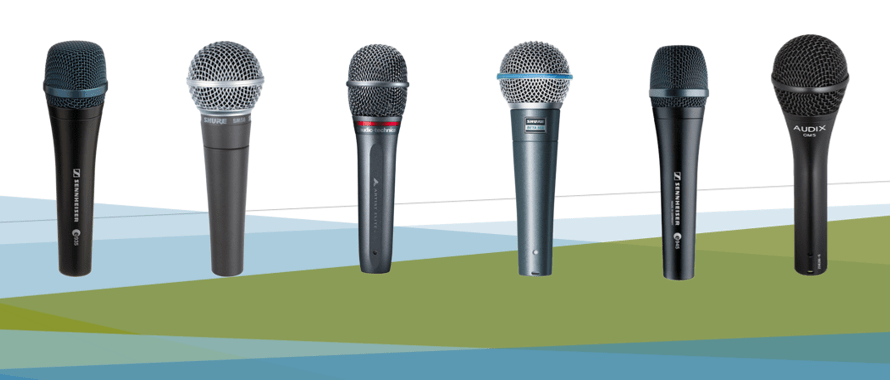
Live performance is the most authentic way of bringing your music to your audience, and the live experience depends as much on your audio equipment as it does your skills and talent.
When it comes to live vocals, you can either chose a dynamic or condenser microphone and choosing the proper mic is crucial. Your vocals must come through a mic with the power to deliver true sound in order to reflect the correct stage presence.
Choosing the best vocal mic for live performance depends largely on personal preference, though your music genre, budget, vocal style, and sound system are all factors. This article contains our review of what we feel are the six best dynamic microphones on the market today.
Of course, finding the best mic for live vocals also requires a core understanding of the technology behind the design. So, we have included some tips at the end of the article for choosing the best mic for stage performances, as well.
The Top 6 Dynamic Microphones in the market today are:
Let’s take a closer look at each one of them in detail.
Shure SM58
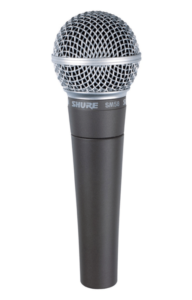
The SM series is an industry-standard and an affordable price to boot. The SM58 is designed to be a vocal microphone with its cardioid polar pattern. This popular Shure model is an upgrade to Shure’s 565SD mic and improves just about all its features.
Design and Features
This Shure handheld mic has a classic design with the retro stick with a pop filter. The enamel panel and steel mesh grille are equally classic, going back to the 1960s. The ball grille protects the cartridge and keeps you from getting too close. It also filters out undesirable noises.
This mic is available in four different package variations.
- One is the Shure SM58-LC, which comes with no cable.
- Next is the Shure SM58-CN, which comes with an XLR cable.
- The Shure SM58S has an On/Off switch, and
- The Shure SM58-X2u, which comes with an XLR and a USB signal adapter.
Additional specifications include a frequency response for this model that ranges from 50Hz up to 15000Hz. The impedance rates at 150Ω (300Ω actual), and the sensitive range fall between –54.5 dBV/Pa (1.85 mV)
How Does It Sound?
The sound on this dynamic mic is excellent for vocal and speech use. The cardioid polar pattern helps stop unwanted noises from being picked up on stage.
The SM58 offers an exceptionally flat response from 100Hz to 4kHz making it perfect for vocals. The mic lacks to provide high-frequency gain. The response between 10kHz to 14kHz has a 0dB gain, and there is only about 2dB gain at 15kHz.
What this means in sound terms is that it would need to be equalized heavily for higher frequency gains. It sounds like retro microphones, remember it was introduced back in 1966.
If you want a crisp, bright sound, this mic is not for you, but if warm, natural soothing sound is what you are looking for, then this is the perfect mic for you.
Pros
Hands down, the best features of the Shure SM58 is the clarity and durability. You can knock this mic around onstage and still expect it to deliver an outstanding sound every time.
- It has a robust dynamic range that delivers clear vocals.
- And it’s rugged enough to take a beating during the most raucous of stage shows.
- The quality and durability also come at a fair price, which is largely why the Shure is an industry-standard.
- In addition, it has a unique pneumatic shock-mount system that further cuts handling noise. For these reasons, this mic is an excellent choice for live artists in particular. Though, it’s certainly suitable for recording speech and vocals.
Cons
- Most customer reviews rave about the sound quality, though a few take issue with it when it comes to recording vocals.
- Other users recommend purchasing the version without the On-Off switch since it’s too easy to forget to flip the switch before walking onstage. Whoever runs your soundboard won’t have to troubleshoot a turned-off mic.
I have personally used the SM58 for miking lead and backup singers. Even though this is one of the lesser expensive models in Shure’s SM line, it’s nonetheless a good choice for professional vocalists. This model has stood up to performers of all genres and venues, making it a must-have for singers.
Audix OM5
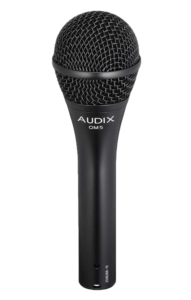
The OM5 is a handheld hyper-cardioid condenser microphone that is gaining popularity as an excellent vocal mic. Audix designed this mic for both live lead vocals as well as background vocals. To accomplish this, the mic is natural and true in its representation of your voice.
Design and Features
The OM-5 has a hyper-cardioid pattern, which makes it above board when it comes to off-axis rejection (when compared to its standard cardioid competitors). With this mic, you experience fantastic isolation.
- The OM5 has a frequency response range of 48 Hz to 19,000 Hz and certainly lives up to Audix’s intended reputation as an industry leader.
- In addition, the low mass diaphragm yields a higher output combined with an extremely fast transient response.
- It’s capable of handling sound pressure levels up to 144 dB.
- As required of a live mic, this model is durable with a touch of design. The body is tapered and has a smooth, sleek finish.
How Does It Sound?
The sound of the Audix OM-5 is outstanding for live sound. Firstly, between 100Hz and 40Hz there is a -10dB bass roll-off which greatly helps reduce the proximity effect.
A slight gain of 2.5bB is present between 100Hz and 500Hz which delivers clear low-midrange frequencies.
The magic happens between 4kHz and 12kHz. The frequency response has a gain of 5dB on average with a 7dB at 12kHz.
This means that this mic can deliver a very accurate sound that is crystal clear at high frequencies, with a slight mid-range boost.
Because of the well-designed polar pattern, which Audix mics are known for, your result is minimal feedback from any monitors that are close to the front of the performance area. The mic delivers a true, undistorted sound that enhances both male and female vocals.
Pros
In addition to the quality sound, the OM5 is exceptionally natural, both in the hand as well as in performance. The newer design is engineered for greater precision in the pickup pattern, as well as the frequency response.
If you’re looking for a true sound for a sound system without phantom power, which is required for condenser mics, the OM5 is your best choice. It won’t give you an unwanted bass-boost or proximity effect. Your trebles will sail through without feedback or ringing.
Also, this mic is sturdy and holds up performance after performance.
Cons
If you are a fan of Audix mics, then you’ll no doubt be pleased with the OM5. For users who are long-time users of the Shure SM58, however, you may have difficulty adjusting.
The SM58 is touted for its midrange push, while the Audix OM-5 is designed for better sound detail. It all comes down to sound taste at the end.
All in all, the OM5 is a formidable model from Audix, a company with a long-standing reputation for quality microphones. For the money, you get a mic that delivers clear sound on stage with little to no feedback. Any drawbacks are more due to user preference than they are to flaws in the design.
Shure BETA 58A
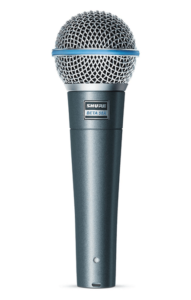
The Beta 58A is a more expensive version of the SM58. While the SM58 is one of the best dynamic microphones ever manufactured, the Beta 58A deserves its own discussion.
While the SM58 remains a favorite, vocalists are being won over by the 58A, replacing its predecessor as the best vocal mic for live performance.
Design and Features
Think of the Beta 58A as a more sophisticated evolution of the notable Shure SM58.
- Like its predecessor, the Beta has a sleek look with its all-metal chassis and steel mesh grille.
- Shure took some time to make this new grille even more rugged. It’s more resistant to dents and other damage. The result is a robust microphone that keeps up with the SM58.
- The grille features a signature blue strip where its two hemispheres meet.
- Another major upgrade is the improved super-cardioid polar pattern as compared to the standard cardioid on the SM58. This upgrade gives the mic more focus and reduces feedback while you’re on stage
- Next, the Beta has a far more advanced pneumatic suspension system, which houses the capsule. It better isolates the diaphragm, creating a quieter mic than its cousin, the SM58.
- Finally, the Beta 58A has a stronger Neodymium magnet, which raises the output and significantly boosts sensitivity.
How Does It Sound?
Logically, the upgraded hardware does more than making a rugged mic. It boosts the performance of the mic as well as enhances the sound quality. The mic delivers clarity as well as a bright midrange.
This microphone was tailored to provide a condenser like sound while using a dynamic microphone topology. Of course, a condenser microphone would be much crispier at high frequencies, but this mic delivers a much brighter sound than regular dynamic mics thanks to its very sensitive membrane.
From 300Hz down to 50Hz there is a -10dB bass roll-off which controls the proximity effect. The mid and high frequencies have consistent gains between 1-5dB, delivering a crisp and clear sound, excellent for soloist singers.
The stronger Neodymium magnet boosts sensitivity and output level response, especially the upper end of the mic’s range.
Pros
Perhaps the most significant feature of this mic is the superior sound. As legendary as the SM58 is, it can’t compete with the design of the Beta. With this mic, you get a powerful, crystal clear sound with ample gain.
Another plus is that Shure is a proven brand, so you are guaranteed dependability and quality with any model microphone bearing the name.
The super-cardioid pattern does a great job of reducing extraneous noise from surrounding instruments or other performers. While a less-experienced vocalist may have trouble staying within the pickup pattern, a more seasoned one will be able to hold the mic properly. He or she will experience solid and consistent sound.
Cons
In some cases depending on the voice, especially males with low pitched voices, the sound needs to be tweaked a bit at lower frequencies to adjust the proximity effect. Then, the mic is spot on for both females as well as male vocalists.
This mic is another mic that I have used for many years with awesome results. Overall, the Beta 58A is a formidable successor to its big brother, the SM58. All the design upgrades lead to smoother performance. Because of all the redesign, the price is higher than the popular and affordable SM58. Though, I think it’s worth the investment.
Sennheiser e935
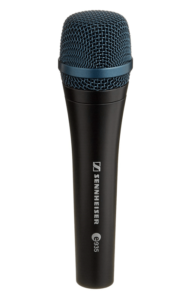
The Sennheiser e935 is a reliable dynamic microphone at an affordable price. In addition, it’s a good-looking microphone with a striking back chassis and dark blue mesh grille.
The design is simple, yet the look is stylish. Hundreds of well-known vocalists use Sennheiser mics and attest that the e935 is one of the best vocal mics for live performance. Here’s why.
Design and Features
True to the Sennheiser name, this mic contains standard features constructed and designed with quality in mind.
- The e935 feels well-balanced and rugged. Sennheiser backs this claim with a 10-year warranty. The e936 contains durable hardware.
- It’s solidly constructed with a shock-mounted capsule, a Neodymium ferrous magnet, and a hum-compensating coil. This combination creates a consistently noiseless performance.
- The microphone comes with a stand clip mount and a zippered carry case.
- The frequency response range is 40Hz to 18kHz, and the sensitivity comes in at -51dB. This mic has an output impedance of 350 ohms.
How Does It Sound?
The e935 is designed with a standard cardioid polar pattern that keeps the mic focused on your voice while on stage. The cardioid pickup pattern provides more than adequate insulation from other on-stage signals.
The frequency response on the e935 is practically flat between 200Hz and 2kHz. From 2kHz to 12kHz there is a gain of about 5dB. Translating this to simple English, basically, the microphone provides you with clear warm sound and just slight brightness, but not too overpowering.
With the especially smooth response range, you have room to equalize the sound to your likings. Further, the sound is balanced through the upper end. It won’t top out on you as other microphones do. Rather, it reaches its upper limit gradually which is excellent for female or male vocalists with a bright and strong voice.
While it can handle recording instruments, this mic is best used for vocals. You’ll have enough power to rise above the mix, but not so much that you’re pushing the limits of the mic’s capabilities.
Due to the internal shock mount and humbucking coil, the e935 is quiet, with low handling noise. It also has consistent off-axis rejection.
Pros
The Sennheiser mic has several advantages over the competition.
- We concur with many of the customer reviews that state the e935 has excellent tone and clarity.
- Along with that are the superior frequency response and balanced gain pattern.
- It’s comfortable in your hand, and it visually attractive as well with the metallic blue windscreen.
Cons
While most reviewers have raved over this Sennheiser mic for live vocals, there are a few drawbacks.
- There have been some complaints that the mic performs better on a stand rather than in the hand due to its sensitivity. While it’s got excellent dynamics, your mouth may need to remain at a fixed distance from the mic, making a stationary stand the better option.
- Others have stated that they need to retune the mic to reduce pops and balance the sound. Adjusting the EQ and volume settings, along with adjusting the proximity of the singer’s mouth to the mic, solves the problem.
- Some users report that the sound is tinny and thin, we have found that it has to do with the equalization settings. Depending on your speaker system and the venue where you are performing, some minor EQ adjustments may be necessary. By doing so, the sound is crisp and balanced.
Having used this mic for several years in my church I can say that overall, the e935 holds its own and is another quality product offered by Sennheiser. For the price, it’s a formidable mic that’s well suited for live vocals. It looks as good as it performs, making it a great choice for live singing or speaking.
Audio-Technica AE6100
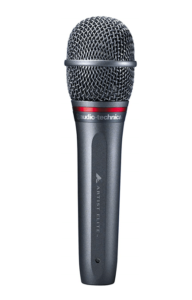
The Audio-Technica AE6100 brings studio-like features to live performance. With its unmatched sound quality, it’s like taking the best sonic characteristics of the SM58 and combining it with the crisp detailed sound of the Audix OM-5.
Plus it features an open-cell foam pop filter that’s built right in. This added feature makes this dynamic mic more expensive than other popular models, though you do get what you pay for.
If you have a need for a stage-ready mic, the AE6100 may be the best dynamic mic you can find. It’s one of the best live performance microphones.
Design and Features
The built-in pop filter pairs well with the AE6100’s hyper-cardioid polar pattern and anti-shock engineering.
- The pop filter design consists of a steel outer grille configuration that’s lined with steel mesh against a layer of open-cell foam. At the top of this configuration is a foam disk that adds an additional layer of pop filtering.
- It touts one of the best rates for feedback rejection. In addition, its anti-shock features cut handling noise significantly.
- This model mic has a frequency response that ranges from 60Hz-15kHz.
- And, the impedance comes in at 250 ohms.
- Combined, these features enable the mic to deliver sound with high clarity, low feedback, and all with a quiet operation for live vocals as well as recorded vocals. In other words, this stage mic delivers studio-quality sound onstage.
From an aesthetic standpoint, the mic’s design is less flashy than others on the market. The look is plain. There’s no fancy blue or another color embellishment to the grille. What you get are ruggedness and superior sound quality.
How Does It Sound?
The AE6100 delivers consistently clean articulation and high-output sound on stage every time. Audio-Technica designed the polar pattern specifically for a superior on-axis response.
The AE6100 represents the full warmth and richness of your voice. Further, it filters out surrounding noise with precision, allowing you to deliver only your vocals.
On the more technical side, the response of this mic is exceptional. As most high-quality dynamic microphones, it has a -10dB bass roll-off between 50Hz and 150Hz for keeping the proximity effect in check.
In addition, it features a linear flat response between 250Hz and 1kHz, with a subtle boost between 1kHz and 5kHz and an average of 6dB gain between 5kHz and 10kHz.
In simpler words the sound from this mic is like combining the flat response of the SM58 and adding the slight mid and high-range boost of the Audix OM-5, delivering awesome presence with crisp highs and balanced mids and lows.
Pros
- Sound clarity is the best advantage of this mic. The added pop filter feature adds to its performance. The mic’s construction is basic but solid, compact, and durable. It’s easy to use and easy to hold in your hand.
Cons
- Other than the slightly higher price, there are no negatives on this mic.
Note: The hyper-cardioid pattern rejects feedback as advertised, though you must be deliberate with the proximity of your mouth to the mic.
In summary, the AE6100 by Audio-Technica delivers. You’ll experience natural, excellent sound quality with almost zero feedback, making it a fantastic microphone for stage use as well as for home studio recording.
Sennheiser e945
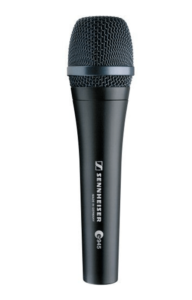
Sennheiser’s handheld dynamic mic, the e945, it’s the company’s flagship model. If you’re going to buy a Sennheiser for live or recorded vocals, the e945 is the one. The e945 mic delivers clear sound on vocals, which makes sense since it was designed for live stage performances.
Design and Features
This dynamic mic capsule features a super-cardioid polar pattern that captures every detail of your vocals so that they are clear even on the most raucous of venues.
- The mic capsule is shock-mounted to prevent impact further and handling noises. Handheld mics take a lot of shuffling and rough handling. When this happens while the mic is in use, both you and your audience will be disturbed, and your performance interrupted.
- This Sennheiser has super-low sensitivity to the handling as well as impact noise.
- This high-performance design is further strengthened by something called hum-compensating coils that prevent electrical interference.
- The e945 has a Neodymium ferrous magnet fortified with boron. This type of magnet does not waver under environmental changes.
- It has a frequency response range of 40Hz to 18kHz and an impedance of 350 ohms
- The case is solid metal, making it durable and reliable during live performances.
- The design includes a falcon ring, which creates a consistent sound over time.
How Does It Sound?
Having used this mic for many years I have found that it delivers an accurate reproduction of a singer’s voice. The design promotes power and clarity for live performances. Other users have agreed, stating that the mic works with no feedback or distortion from unwanted signals.
Thanks to is flat mid-range frequency response and slightly boosted high frequency response it delivers a warm sound with accentuated crisp details.
The e945 mic only picks up sound coming directly from the front and behind it. Any sounds that may be generated on stage do not interfere with the mic and, thus, your vocals. The result is a clean delivery every time.
Because it’s designed for easy handling and is shock-mounted, the mic has a low sensitivity to impact. So, you won’t have any undesirable pops and other noises interfering with your performance.
Pros
- Time after time, users attest that this mic improves the natural quality of their vocals, from the clarity to the noise reduction and feedback suppression.
- These same users are also pleased with the Sennheiser’s durability and long-term reliability for stage performances.
Cons
- As with any brand and model mic, singing style and personal preferences influence a vocalist’s opinion of a microphone.
- Some users report a tinny sound or the opposite, a more low-end delivery than they’d like. In our experience, adjusting the EQ levels takes care of that.
In summary, the e945 by Sennheiser is the company’s best-selling model because of its craftsmanship and quality sound. The price is comparable to its competitors.
Due to the great sound with almost zero feedback, many reviewers including me state that this is the best microphone for live singing, no matter what type of voice you have.
Tips for Choosing the Best Vocal Mic for Live Performance
When choosing a microphone for your live stage performances, you have a lot to consider beyond budget and style preferences. We’ve put together a short guide to help you choose the best microphone for your live performances.
When researching microphones, you’ll hear terms like dynamic, condenser, frequency response, and polar pattern. Most of you are familiar with these terms. If you are not, then take a look at the guide below to see how they apply to microphones and your personal preferences.
The first concept you’ll need to understand is the difference between a dynamic microphone and a condenser. Both are designed for live performance, though there are distinct differences between the two.
Condenser Vs. Dynamic Microphones
For live vocals, there are two types of mics from which to choose. Those types are dynamic and condenser. Dynamic microphones are usually best for live performances because they are less sensitive than condenser mics. Having low sensitivity means the mic is less prone to bleed and feedback during a stage performance.
Even so, many vocalists and sound engineers prefer customized condenser microphones because they deliver superior sound quality and clarity when compared to dynamic mics.
Dynamic Microphones
Dynamic mics are less sensitive than condensers. They employ a copper coil attached to a membrane which responds to sound. From there, the vibration interacts with magnets inside the coil, which creates an electrical current.
A dynamic mic picks up a higher volume of noise. Though, it can miss some of the more subtle details of the voice, which is why many professionals prefer the condenser type.
Further, dynamic mics are tougher and hold up better than condensers. Performers often prefer them for this reason alone.
Condenser Microphones
Often, professional speakers and vocalists prefer a condenser microphone rather than a dynamic one. Condenser mics pick up more details, including inflection and other nuances of the speaking or singing voice.
Of course, this also makes condensers far more sensitive to other noises in the background. During live music performances, this can create distortion.
Condensers are also more delicate when it comes to durability. Often, they are reserved for studio recording for this reason.
Overall, condensers are less versatile than dynamic mics. Though artists do use dynamic mics for studio work, and others are successful with condensers for stage work. Many vocalists take more time to fine-tune the EQ settings or pair with additional sound-enhancing equipment.
Next, let’s talk about frequency response.
Frequency Response
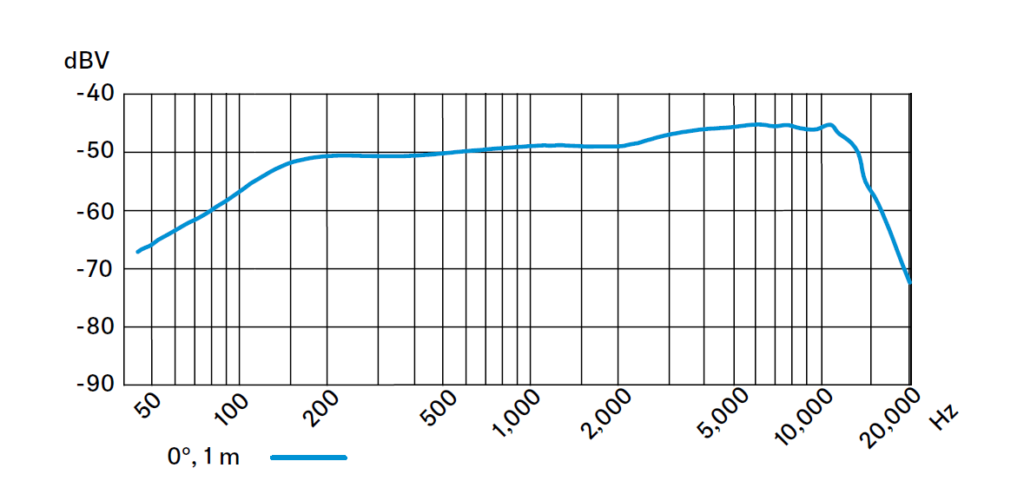
Dynamic and condenser mics are receptive to different frequencies. For example, a flat response mic responds to all frequencies in the same manner, which can be a drawback for live performances and other applications.
Manufacturers more often customize the frequency response to respond to certain frequencies that enhance its performance for live vocals, studio recording, or both. For instance, some mics deliberately dampen bass or treble frequencies, while other models intentionally enhance them.
Whenever possible, you should try a mic before you buy one of your own. Certain models will better suit your vocal tone and pitch. After all, your mic should showcase your range rather than muddy it.
Another essential part of your purchasing decision has to do with the microphone’s polar pattern.
Polar Pattern
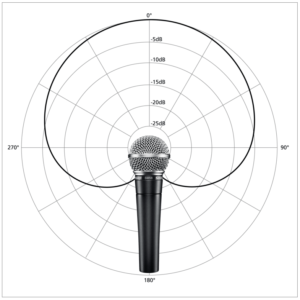
When discussing the polar pattern of a microphone, understand that the polar pattern is the directional shape of the microphone’s field of sensitivity. It is the direction from which the mic either ignores or accepts sound.
When it comes to live performances always chose one of the following polar patterns to reduce feedback and noise: Cardioid, Super-cardioid, and Hyper-cardioid Patterns. To learn more about each one of these patterns read this post
Conclusion
In conclusion, choosing the best microphone for live vocals depends on several factors, from your own vocal style, the pitch and tone of your voice, and your preferred sound. Polar patterns are also an important consideration when it comes to the degree of sensitivity you require for your live performance or studio recording.
We have included our reviews of the six microphones we feel are the best for live vocal performances. Each is priced well and comes from industry leaders. All are designed with quality and durability in mind, though each has design specs that set them apart from the others.